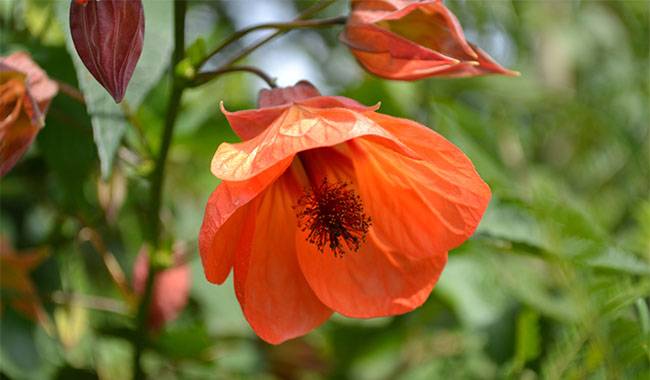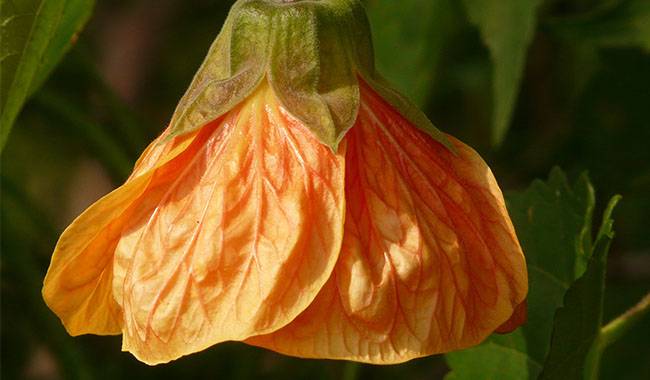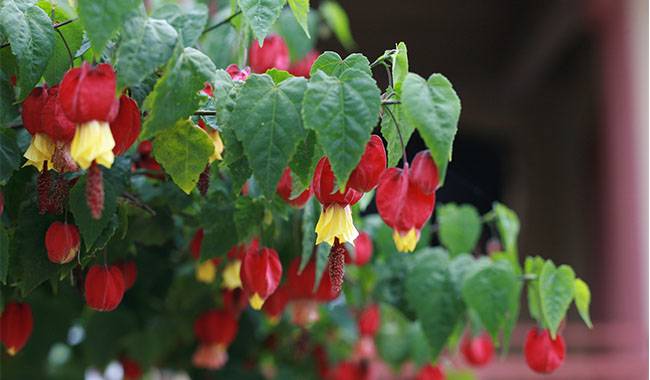
Despite their simple name (Indian Mallow) and the fact that they are a modern alternative to indoor hibiscus, Abutilon is not the easiest plant to grow. They grow well under only optimal conditions, bloom abundantly, and enjoy a healthy green appearance. The delicate foliage quickly shows up in any deviation from comfortable light or temperature, and in the event of care violations. To discover the beauty of Abutilon, which is now almost common in the room, it is worth finding a truly ideal place for it. You will learn How to Care and Grow Abutilon in the ThumbGarden article.
CHOOSE A “RESERVED” PLACE
Abutilon is hardly the easiest houseplants to grow. But they should not be regarded as very capricious either. They require careful care and do not allow for any major breakdowns. They will thank their care and attention with fruitful growth and abundant flowering when the large, delicate bells bloom in countless flowers against the velvety backdrop of their huge foliage.
Abutilon’s main strength is also its great challenge. Their rapid growth requires not only a lot of space but also special attention. Abutilon is vigorous growers, quick to respond to problems, and their foliage tends to lose its decorative qualities at the slightest discomfort. It is best to take this feature into account.
Abutilon plants are becoming increasingly popular due to their ease of propagation.
But in order not to be disappointed with indoor Abutilon, it is worth setting yourself up to create the ideal conditions for the plant as much as possible. Sometimes the “little things” don’t matter compared to the general principles of site selection and care strategies.
Abutilon is not an indoor breadcrumb. And they’re not even compact shrubs. They develop quickly and vigorously, and even when shaped and controlled, they still show their true nature. And they can only be placed temporarily on a windowsill. The little ones spread out quickly.
Abutilon’s habitat should be considered in advance. Basic requirements: adequate light, temperature conditions, and, of course, the possibility of development in all directions. The bushes must not be supported by any objects, furniture, or walls: they must stand freely and have access to the air.
HOW TO TAKE CARE OF ABUTILON PLANTS AT HOME

Proper lighting
The basic space requirements for Abutilon plants are fairly simple. In order for an Abutilon to be comfortable in its chosen room, it needs good light and a warm “room temperature” rather than excessive heat, constant peaks, and cold drafts.
Abutilon spp. is a light lover, preferring bright light and long daylight, but avoiding direct sunlight. Diffused light without the risk of sunlight is an ideal choice.
Artificial supplemental lighting for Abutilon should only be used as an additional measure to extend bloom time on cloudy days. For rest periods, increase light by moving the plants closer to a window, but still avoid direct sunlight, as plants are especially vulnerable to sunlight in winter.
One more secret – protect Abutilon from any changes in light. It does not like changes in light or being moved suddenly, and it reacts to such changes with great pain. Rapid movement in the sun is particularly dangerous, leading to the loss of leaves, buds, and flowers.
Optimal temperature
Abutilon does very well in active vegetation and during flowering at any room temperature above 64 °F (18°C). Heat is a disadvantage, but it is easily compensated for by frequent spraying of the foliage with water and the installation of humidifiers.
With Abutilon, you should not choose a room with a constantly changing environment and temperature, including the kitchen. However, in general, it is worth paying attention to the temperature only during the dormant period. A cool environment is essential for abundant flowering and the normal development of the plant. Ideal overwintering conditions: between 50-59 °F (10-15°C.) Abutilon plants can also tolerate lower temperatures.
Provide fresh air for indoor Abutilon
Although Abutilon does not have anything in common with Abutilon or linden trees, it is best to treat them as semi-garden plants in terms of their regular exposure to fresh air.
First of all, any opportunity to bring the plant into the fresh air – on the balcony or in the garden – is best utilized. Of course, you must control the temperature at night and protect Abutilon from cold temperatures, even down to 59 °F (15 °C). But such an air bath will only benefit both the aesthetics and the health of the Abutilon.
When placed outdoors, care should be taken with light, remembering not to increase it dramatically, and that Abutilon does not like drafts or wind. It will prefer a semi-shady, secluded, warm place. For example, Abutilon is often used to decorate patios.
Simple and regular care
In many ways, Abutilon is the most typical of the abundant flowering plants. It requires almost standard care and will not tolerate failures in watering or fertilizing. If you want to create a truly ideal microclimate for Abutilon, it is worth checking the condition of the plant and substrate regularly.
Water heavily after the top few inches of the substrate has dried to avoid standing water and constant humidity in the tray. Complete drying of the soil is not allowed as the plants will react immediately by dropping their leaves and buds. Therefore, it is worthwhile to provide an automatic irrigation system for holidays or business trips.
Automatic irrigation systems also work well as a permanent method of growing indoor Abutilon. Water Abutilon flowers sparingly during the cool winter months, and if possible try to sprinkle on the canopy regularly rather than wetting the soil unnecessarily.
Abutilon plants only need humidity measures when they are below average. Humidifiers and careful sprinkling can do the same thing.
Abutilon plants have an increased need for nutrients. In this respect, they are more like typical garden potted plants. For them, fertilization is required only from the beginning of growth to the end of flowering, but often once a week.
It is best to cut the recommended dose in half and use a fertilizer specifically for flowering plants. It is easy to see if the plant has enough fertilizer: with optimal fertilization, the leaves are horizontal and seem to stick out, while with insufficient fertilization, the leaves look down.
Shaping Abutilon is very simple. Keep them within the desired size by simply pruning them each spring, most often – by cutting one-third to one-half the length of the shoots. Pruning promotes the growth of lateral branches and new leaves as well as flowering.

DISEASE AND PEST PREVENTION
Abutilon can only get sick if serious, systematic mistakes are made during cultivation. By providing them with everything they need, you will also ensure that the plants remain healthy for years to come. Of course, if a shrub stands next to a pest-infested crop, the pest will spread to the lush Ficus macrocarpa. But if you follow all the rules, you won’t have a problem.
Abutilon plants are more susceptible to whiteflies and aphids, although they can also be infested with spider mites if not cared for properly. In addition to all types of decay, they can also suffer from powdery mildew.
Once plants are isolated, it is best to begin treatment immediately with biological, mechanical, or chemical agents that target the problems occurring on the plants.







